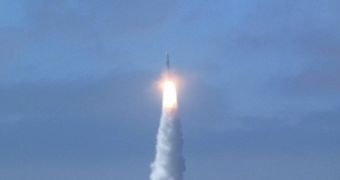And indeed, Microsoft has launched a Bing rocket. Not the Redmond company itself, but rather DigitalGlobe, one of the software giant’s partners and supplier of satellite imagery for Bing Maps. The past week, DigitalGlobe’s Boeing Delta II 7920 rocket launched from Vandenberg Air Force Base in California taking the WorldView-2 satellite into orbit. Following the first couple of days when WorldView-2 had to undergo calibration and checkout, DigitalGlobe started capturing imagery, which will end up integrated into the Redmond company’s mapping, search and location platform.
“The rocket was just a propulsion engine to begin the orbit of Digital Globe’s new WorldView-2 satellite which will capture imagery of the Earth and eventually be added into Bing Maps. The process is actually quite complex and now that our Bing logo is floating in the ocean evangelizing to scuba divers, let the imagery processing begin! (Perhaps we should roll out some bathometric data on Bing Maps to coordinate with the rocket in he water)? In any case, the first photo isn’t actually taken for 48 hours. The satellite will have orbited the Earth twice before they crank the lens to face the sun (to obtain a perfect white color synchronization). Then, after the first 48 hours Bing! the first photo is taken,” revealed Chris Pendleton, the Bing Maps technical evangelist for Microsoft.
Moving forward, Bing Maps will grow with an infusion of new content supplied by WorldView-2. According to DigitalGlobe, the satellite is capable of collecting multispectral imagery at 1.8 meter resolution and panchromatic imagery at .46 meters. Pendleton noted that the satellite would primarily be used to capture imagery designed to correct areas of Bing Maps lacking in coverage.
“The successful launch of WorldView-2 is an important milestone for the industry and for DigitalGlobe,” noted Jill Smith, chairman and chief executive officer of DigitalGlobe. “Once commissioned, WorldView-2 will effectively double DigitalGlobe’s collection capacity, enabling us to provide at least annually updated coverage of the world as well as intra-day revisit for more rapid and reliable collection for our customers. Additionally, WorldView-2’s eight spectral bands will significantly enhance our ability to meet our customers’ needs for feature identification, change, detection, and other high-value services.”

 14 DAY TRIAL //
14 DAY TRIAL //